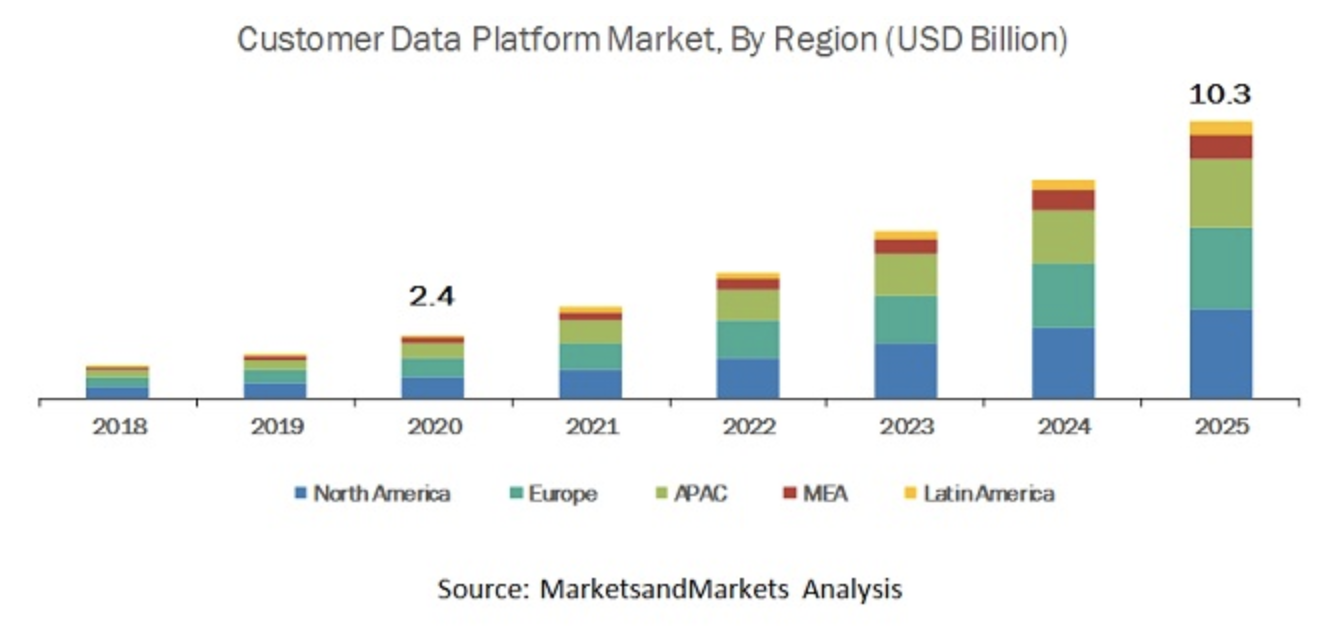Access our on-demand webinar where industry experts unpack the hidden world…
Key Takeaways:
- The future state of marketing includes a customer-first data strategy that aggregates customer interactions and operationalizes them within your communications.
- Employing a customer data platform, which organizes and categorizes customer interest, can be a key differentiator for your company.
- The number of CDP use cases to drive revenue is endless; however, by starting with these five your company should quickly see a return on investment.
An analogy often used by psychologists and life coaches is that you “can’t drive forward looking in the rearview mirror.” While the past should be used as a guide to grow and learn from, if you continue doing things the same way they’ve always been done it’s unlikely that things will change for the better.
The same philosophy applies to business, marketing in particular. There is more technology, as well as more distribution channels, than ever before. Coupled with increased customer expectations and greater ownership for revenue growth, there are few functional units within a company that have changed as much as the marketing department. Marketers who are unwilling or unable to evolve risk the same outcome as a driver moving forward by looking in the rearview mirror.
An ideal future marketing state means a customer-first strategy where data is gleaned from user interactions on your website, ad platforms, sales or e-commerce channels, fulfillment and customer support systems and woven together to present an individualized view of each customer. This view can be accessed dynamically, in real time, to intervene in the customer’s journey with relevant messages for both known and unknown users in any marketing or sales channel to drive buying decisions. The results of those interactions can be tracked and attributed back to the campaign and asset level, where they can be analyzed for machine learning and AI to drive future revenue.
You’re probably thinking, “That sounds good in theory, but it isn’t possible for a myriad of reasons,” (such as siloed teams, inability to collect and aggregate customer data, too many tools/systems, lack of leader buy-in and not enough or the right resources). In the past, those have all been valid constraints — but not any more.
The first reference to a customer data platform (CDP) can be traced back to 2013. Since that time the concept has grown in popularity and is on the cusp of being considered a major component of a marketing technology stack, on par with CRM, marketing automation and content management systems. While the theory of connecting customer activities in an integrated manner has been around for years, it wasn’t possible until recently, at least not in a scalable manner. In execution many early adopters of this approach used point-to-point integrations (i.e., CRM to and from marketing automation) or attempted to aggregate, map and clean data in a database or data lake to be used in applications. While this was a step in the right direction it took significant development resources with complex logic and rules to operationalize these data sets within a business.
While CDP has become a buzzword, with more companies looking into this customer data framework, a recent analysis by Markets and Markets shows the CDP market is poised for tremendous growth — from roughly $2.4 billion in 2020 to $10.3 billion by 2025, at a compound annual growth rate (CAGR) of 34% during the forecast period. We believe that CDPs are the next big marketing technology wave and are where CRM was 10-15 years ago and marketing automation 3-5 years ago.

Here are some signs that your company might be ready to consider a CDP system:
- Need a complete and consistent view of its customers.
- Want to personalize the experiences of your customers in the moment (real-time sub-200 milliseconds).
- Needs to tie offline and online customer data together.
- Technology evaluations underway for CRM, email, tag management, etc.
- Issues integrating customer data to CRM, email, ad tech, cloud providers, etc.
- Upcoming website redesign.
- Lack of resources and skills to manage your data.
Or maybe you are already researching CDPs or feel like you aren’t getting the full value from an existing CDP. Not all systems advertised as a CDP are equal, and we have experience helping find the right solution for each company.
For those of you who are new to this concept, let’s take a step back to say what a CDP is and isn’t. Then we’ll go through a few use cases where this technology, when used appropriately, can solve your business challenges.
At its foundation, a CDP is a data-as-a-service infrastructure that unifies and persists customer profile and other data, from any internal or external source, legally and securely into a single database with a comprehensive view of all customer activities or behaviors. Those activities are then given rules-based activities to create personas in real time that can be activated for any customer-facing communication in every customer channel. This data can also be utilized for analytics, reporting and data science, including machine learning and AI. Last, when done correctly, after the initial implementation, non-technical teams should be able to utilize data within applications using configuration or low or no-code technology, which means marketing sales and customer service teams can own the outputs from the CDP within applications they use every day — CRM, marketing automation, customer service systems and ad platforms — within minimal IT involvement.
While the possibilities of driving revenue and growth with CDP are only limited by your imagination here are five everyday use cases to illustrate how this type of system can transform your business.
Use Case #1: Retargeting
As any fisherman would tell you there is nothing more frustrating than getting a fish to bite on your hook only to lose the catch while reeling the fish in. Most if not all of you can relate to this analogy when it comes to your prospects. Companies spend so much time, energy and money to attract customers to their products and services, whether the goal is attracting visitors to a website to fill out a form for a prospective sales engagement or convincing a user to buy a product directly from you either.
Many industry reports peg e-commerce conversion rates in the low single digits, and landing pages conversion rates are about the same. One of the benefits of a CDP is that it helps reduce your attrition rate by recognizing who is interested but didn’t make the purchase. It allows you to better understand a customer’s interest and retarget him or her or in the appropriate channel, which could be an email with a discount coupon or retargeting the customer with paid social or other messages.
Use Case #2: Audience Suppression
Companies waste significant dollars and marketing resources because data isn’t unified and/or can’t be shared between systems. This could include purchase data, consent, identity, support interactions or engagement/behavioral data. This lack of a single view of the customer means dollars wasted on customers and prospects who either have already converted or likely won’t convert.
It also opens a company up to sending messages that aren’t relevant to a customer’s stage in their purchasing journey, which at best don’t benefit the selling process and at worst push the customer away. A near-universal complaint from customers is disjointed experiences. This could include receiving a coupon after they already made a purchase or being messaged with products that don’t interest them or in channels they haven’t consented to.
Use Case #3: Customer Acquisition and Cross-Channel Segmentation
Every company wants to identify and target new prospects to acquire customers. The idea here is to capture customer activity data from multiple channels — web, point of sale, mobile, etc. That data is then standardized into a profile a company can use to discover the best ways to reach customers and see which messages best resonate in order to increase revenue through better targeting and segmentation.
For example, a technology salesperson living in the Bay Area named John, he is a frequent business traveler with a particular airline. That airline, Airline X, has collected not only his purchase transactions but also his behavior online/app/email and more customer touch points. That data has been centralized into a profile that tells John’s story. Based on his lifetime value to the company, it has added him to four key persona groups, which trigger specific outreach actions when he is interacting with the brand.
John is looking to book a business trip to Denver for a trade show later this year. He starts looking for a flight but quickly abandons his cart. The airline sends an abandoned cart email and places him into a retargeting campaign, to no avail. As the flight is close to selling out the campaign, a notification is pushed to John’s mobile device, which convinces him to book the flight.
The system then removes him from ongoing campaigns (see use case #1 above) and the company caters to his needs by triggering transactional communications to make for a better experience to create future loyalty (lifetime value).
Use Case #4: Machine Learning and Predictive Insights
The biggest obstacle to harnessing machine learning and predictive insights is collecting and standardizing data to find insights and create models that can be plugged back into business systems and processes. Because CDPs collect and standardize data, insights can more quickly be discovered. The tool then allows new algorithms and models to be plugged back into datasets, which can be dynamically activated in campaigns. Think of the value for your company if you are able to identify that showing a particular asset or combination of assets to a customer in a specific order increases either the likelihood of a purchase or the lifetime customer value (or both).
Use Case #5: Data Governance and Consent
There is a significant increase in data responsibility and consent being legislated in most countries (GDPR, CAN-SPAM, CASL, CCPA, etc.) and in some states. It has never been more important to make sure all customer data collection sources are inventoried and processes are in place to determine what data can be passed downstream and what data can’t in order to balance regulatory obligations with growth objectives. Most CDP platforms use a first-party data model rather than relying on second- or third-party data, which can’t be counted on to be legally viable in the future. Additionally, employing a consent manager to log communication preferences helps comply with data collection laws and ensures you are communicate in channels where legally viable consent has been obtained. By creating this data infrastructure you know where all customer data resides, both to create opportunities but also to comply with a user’s request to be forgotten.
There has never been a better time to invest in your company’s data capabilities. Early adopters have the chance to have a significant competitive advantage over their competition. And Zirous, a technology data and insights company established by leading communications, IT and customer experts, is here to help you every step of the way.
We speak the language of business and technology to create customer-centric organizations. Contact us today to learn more.


This Post Has 0 Comments